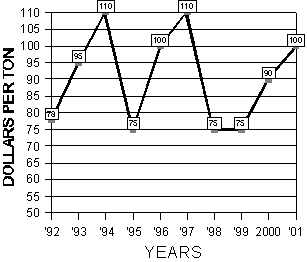Alfalfa Report
Yuma County, Arizona
October 8, 2001
Yuma County Office
2200 W. 28th Street, Ste. 102
Yuma, AZ 85364
(928) 726-3904
(928) 726-8472 FAX
Production Update:
PDF version, 38KB
Alfalfa seeding rate: The optimum alfalfa seeding rate is difficult to define due to variations in seedbed conditions. Emergence of 50 seedlings per square foot is considered a good initial stand. Survival of half the emerged seedlings resulting in a stand of 25 seedlings per square foot during the first year should be adequate. A seeding rate of 20 pounds per acre is equivalent to approximately 100 seeds per square foot for raw seed and 67 seeds per square foot for coated seed. The rate of emergence and seedling survival may both average 50%, although the range may be from 20 to 70%. Plants are lost faster in higher compared to lower seeding rates, and stands after one year are often similar regardless of seeding rate.
Insect Management: Growers establish new stands of alfalfa and replant areas of established fields during the fall months. Several insect pests can be clip seedling alfalfa plants during stand establishment. Monitor new stands for cutworms, crickets as these pests are occasionally abundant enough to thin seedling alfalfa. Sowbugs and pillbugs are crustaceans that damage seedling fields that have not been well tilled, but are most common as pests in re-seeded fields. Palestripped flea beetle is an occasional that damage seedling alfalfa. Treat with an insecticide bait or foliar insecticide when these pests are abundant enough to cause areas of stand loss.
Weed Control: Sencor will control many broadleaf and grass weeds
in alfalfa but causes crop injury when much foliage is present at the
time of application. The best time to apply Sencor is after sheeping.
It works best during the winter months when irrigations are less frequent.
It will leach with frequent summer irrigations.
| Market Summary |
High
|
Low
|
Average
|
Off grade
|
| Past 2 Weeks (Sept. 24 to Oct. 8, 2001) |
105
|
90
|
100
|
80-90
|
| Last Year (Sept. 24 to Oct. 8, 2000) |
95
|
85
|
90
|
70-80
|
10 Year Summary (September 24, to October 8,1992-2001):

Issued in furtherance of Cooperative Extension work, acts of May 8 and June 30, 1914, in cooperation with the U.S. Department of Agriculture, James A. Christenson, Director Cooperative Extension, College of Agriculture and Life Sciences, The University of Arizona.
The University of Arizona is an equal opportunity, affirmative action institution. The University does not discriminate on the basis of race, color, religion, sex, national origin, age, disability, veteran status, or sexual orientation in its programs and activities.
Any products, services, or organizations that are
mentioned, shown, or indirectly implied in this web document do not imply
endorsement by The University of Arizona.
Information provided by:
Barry Tickes, btickes@ag.arizona.edu Extension Agent, Yuma County
Michael Ottman, mottman@ag.arizona.edu Agronomy Specialist
College of Agriculture, The University of Arizona.
Eric Natwick, etnatwick@ucdavis.edu UCCE Imperial County - Farm Advisor
University of California, Davis, CA.
Material written October 8, 2001.
Forages: Crop Mgmt | Soil Mgmt | Irrigation | Alfalfa Reports | Insects | Diseases | Weeds | Pesticides
Home | Other Crops | Forages
For more Arizona Production Ag Information:
Home | Cotton | Veggies| Forages | Grains | Citrus | Crop x Crop | Insects | Diseases| Weeds | Pesticides | News | Weather | Research | Photos | Contacts | General Info. | Site Map
Copyright © 2001 University of Arizona,
College of Agriculture and Life Sciences
Webmaster: Al Fournier (fournier@ag.arizona.edu)